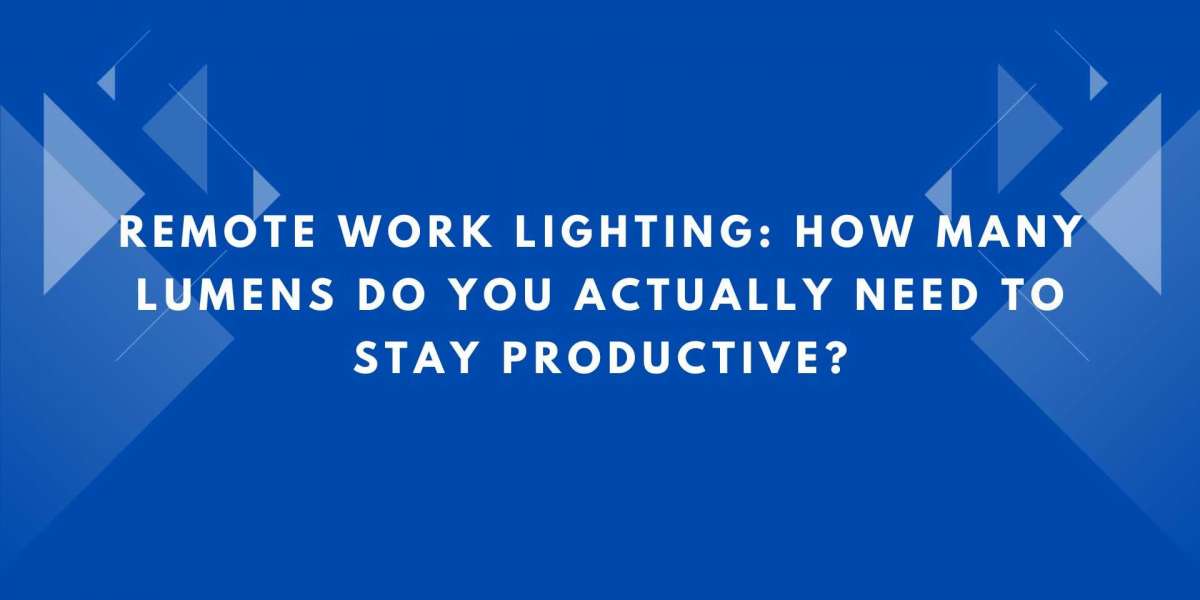In the age of remote work, our homes have transformed into digital offices. From video conferencing to spreadsheet crunching, we now spend hours working under artificial lighting conditions. Yet, one often overlooked factor that significantly affects our productivity is lighting. It is not just about having a lamp on your desk. The right amount and quality of light can help reduce eye strain, improve focus, and even uplift your mood. So how many lumens do you actually need to create a productive and comfortable remote work environment? In this blog, we will explore the science of lighting and how to make it work for you.
Why Lighting Matters in Remote Work
Good lighting does more than just brighten up a space. It plays a key role in our ability to concentrate, stay alert, and remain energized throughout the workday. Poor lighting can cause headaches, dry eyes, fatigue, and even poor posture if you are constantly leaning in to see better. On video calls, it can also affect how professional you appear to colleagues or clients.
In short, getting your lighting right is a form of productivity hacking. And the first step to achieving that is understanding how many lumens do you actually need based on your space and tasks.
What Are Lumens and Why Should You Care?
Lumens are a measure of light output. The higher the lumens, the brighter the light source will appear. When you are shopping for desk lamps, ceiling lights, or light bulbs, you will often see wattage listed. However, wattage only tells you how much energy the bulb uses, not how bright it is. Lumens tell you the actual brightness.
For example, a 60-watt incandescent bulb produces about 800 lumens, while an LED bulb using only 10 watts can produce the same 800 lumens. That is why lumens are the better metric for lighting decisions.
How Many Lumens Do You Actually Need for a Home Office?
The ideal lighting level depends on the type of tasks you perform and the size of your workspace. A general rule of thumb is:
For general desk work like typing, reading, or browsing, you need 300 to 500 lumens per square meter.
For more detailed tasks like sketching, writing, or working with documents, aim for 500 to 1,000 lumens per square meter.
For ambient lighting, such as ceiling lights that illuminate the entire room, 1,500 to 3,000 lumens in total is usually sufficient for a small to medium-sized room.
Let us break this down further based on different scenarios.
Desk Lamps vs Overhead Lighting
If you work in a smaller home office or a shared space like a living room, your primary light source may be a desk lamp. In that case, you should look for a lamp that provides 450 to 800 lumens. This will give you a bright and focused beam of light without being too harsh on your eyes.
If your workspace includes overhead lighting, make sure it provides at least 2,000 lumens overall to cover the entire room evenly. Combine this with a good desk lamp for focused lighting, and you will have a well-balanced setup.
So when asking how many lumens do you actually need, it is smart to combine ambient lighting with task lighting for optimal results.
Natural Light vs Artificial Light
Natural daylight is always the best light source. It improves mood, enhances alertness, and reduces the need for artificial light. If your workspace is near a window, you may need fewer lumens during the day. But relying solely on natural light can be tricky due to changing weather and time of day.
In such cases, supplementing with artificial light is essential. During early mornings or late evenings, aim for 3,000 to 4,000 total lumens in your workspace to compensate for the lack of sunlight.
Even with natural light, you should still evaluate how many lumens do you actually need when the light starts to fade.
Color Temperature Also Matters
Brightness alone is not the only factor to consider. The color temperature of the light also affects your productivity. Measured in Kelvins (K), it ranges from warm white (2700K to 3000K) to daylight (5000K to 6500K).
Warm white light (2700K to 3000K) is relaxing but may not be ideal for focused work.
Cool white light (3500K to 4100K) is more energizing and better for concentration.
Daylight (5000K to 6500K) mimics natural sunlight and is ideal for task-intensive environments.
When combining brightness with color temperature, your lighting becomes more effective. A light with 600 lumens at 2700K will feel dimmer than one at 5000K, even if the lumen rating is the same.
Tips to Optimize Your Home Office Lighting
Layer your lighting: Use a combination of ambient lighting, task lighting, and accent lighting to create depth and reduce eye strain.
Avoid glare: Position lights to avoid reflections on your screen or shiny surfaces.
Use dimmable lights: Being able to adjust the brightness according to the time of day helps maintain comfort.
Consider smart lighting: Smart bulbs can adjust brightness and color temperature automatically based on the time of day.
Clean your fixtures: Dust and grime can block light and reduce effectiveness.
Conclusion
The right lighting setup can dramatically improve your focus, comfort, and productivity while working from home. It is not about having the brightest light, but about having the right type and amount of light for your specific needs. Whether you work in a small corner of your living room or a dedicated home office, understanding how many lumens do you actually need is the first step to creating a productive workspace.
By assessing your room size, natural light availability, and the tasks you perform, you can choose the perfect lighting solution to stay sharp and energized throughout your workday. Remember, the goal is to work smarter, and lighting is one of the simplest yet most powerful tools to help you do just that.
Read more: https://znajomix.pl/read-blog/8764








